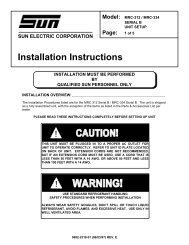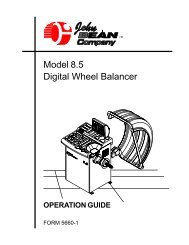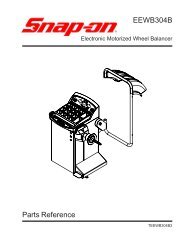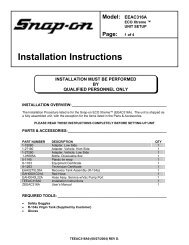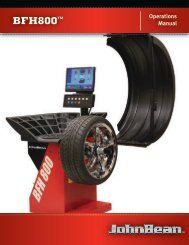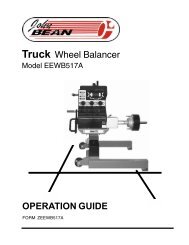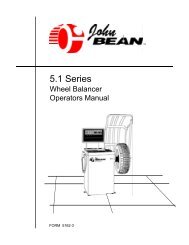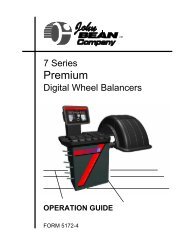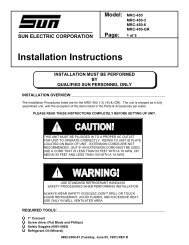MRC-400 "B" INTRODUCTION - Snap-on Equipment
MRC-400 "B" INTRODUCTION - Snap-on Equipment
MRC-400 "B" INTRODUCTION - Snap-on Equipment
Create successful ePaper yourself
Turn your PDF publications into a flip-book with our unique Google optimized e-Paper software.
<str<strong>on</strong>g>INTRODUCTION</str<strong>on</strong>g><br />
GENERAL<br />
This service manual has four chapters covering the <str<strong>on</strong>g>MRC</str<strong>on</strong>g>-<str<strong>on</strong>g>400</str<strong>on</strong>g>/450 & ACT-4100/4500Mobile Recycling Center,<br />
and MTC-<str<strong>on</strong>g>400</str<strong>on</strong>g>0/4500. The serial B units will be refered to as <str<strong>on</strong>g>MRC</str<strong>on</strong>g>-<str<strong>on</strong>g>400</str<strong>on</strong>g>/450 or <str<strong>on</strong>g>MRC</str<strong>on</strong>g> / ACT. The manual covers<br />
the following topics: AC/DC Distributi<strong>on</strong>, Theory of Operati<strong>on</strong> / Troubleshooting, Maintenance and Calibrati<strong>on</strong><br />
Procedures, and a Parts List.<br />
Use the <str<strong>on</strong>g>MRC</str<strong>on</strong>g>-<str<strong>on</strong>g>400</str<strong>on</strong>g>/450, ACT-4100/4500, and MTC-<str<strong>on</strong>g>400</str<strong>on</strong>g>0/4500 capable of the following functi<strong>on</strong>s:<br />
1. Reclaim, clean, and store refrigerant for reuse.<br />
2. Pull a vacuum <strong>on</strong> an Air C<strong>on</strong>diti<strong>on</strong>ing System.<br />
3. Accurately charge an Air C<strong>on</strong>diti<strong>on</strong>ing System with refrigerant.<br />
4. <str<strong>on</strong>g>MRC</str<strong>on</strong>g>-<str<strong>on</strong>g>400</str<strong>on</strong>g>/ACT-4100/MTC-<str<strong>on</strong>g>400</str<strong>on</strong>g>0: Charges R-12, and R-500.<br />
5. <str<strong>on</strong>g>MRC</str<strong>on</strong>g>-450/ACT-4500/MTC-4500: Charges R-134a.<br />
NOTE: The following is a breakdown descripti<strong>on</strong> for Serial Numbers:<br />
Serial # Locati<strong>on</strong> - Rear Cabinet top right hand side.<br />
Example: 0694B0101<br />
06 M<strong>on</strong>th MFG.<br />
94 Year MFG.<br />
B Serial Rev.<br />
0101 Number of Unit.<br />
NOTE: SERIAL B SOFTWARE STARTS WITH 2.XX ON POWER UP.<br />
FUNCTIONAL DESCRIPTION<br />
Auto Sequence: Press to begin an automatic sequence: Recovery, Evacuate, Vacuum<br />
Hold, Oil charge and Refrigerant Recharge. The unit can automatically recall entries from the last AUTO<br />
SEQUENCE operati<strong>on</strong> by pressing and holding the for five sec<strong>on</strong>ds.<br />
Reclaim Only: Press to recover refrigerant from the air c<strong>on</strong>diti<strong>on</strong>ing system. Refrigerant<br />
gas enters the <str<strong>on</strong>g>MRC</str<strong>on</strong>g>-<str<strong>on</strong>g>400</str<strong>on</strong>g>'s sucti<strong>on</strong> separator through two service hoses. The unit traps oil and solid c<strong>on</strong>taminants<br />
at the bottom of the separator bowl. The pump pulls refrigerant gas from the top of the bowl. Then the pump<br />
compresses the refrigerant to a high-pressure gas. Next, the high-pressure refrigerant gas enters the c<strong>on</strong>denser.<br />
Two c<strong>on</strong>tinuously running fans blow air across the c<strong>on</strong>denser. The air removes heat and c<strong>on</strong>denses the highpressure<br />
gas into a refrigerant liquid. The liquid flows out of the C<strong>on</strong>denser and through the Master Filter/Drier.<br />
The unit collects the refrigerant in the recovery tank. When the unit finishes recovering, the operator panel's<br />
green, COMPLETED LED lights. Unit can display exact amount of refrigerant recovered by pressing the<br />
.<br />
Effective<br />
2/97 Page i
<str<strong>on</strong>g>INTRODUCTION</str<strong>on</strong>g> (B)<br />
FUNCTIONAL DESCRIPTION c<strong>on</strong>tinue...<br />
Vacuum: After you open a vehicle air c<strong>on</strong>diti<strong>on</strong>ing system, you can't immediately recharge it. First, you must<br />
evacuate the system (pull it into a deep vacuum). The Air C<strong>on</strong>diti<strong>on</strong>ing system c<strong>on</strong>tains moisture. Pulling the<br />
system into a deep vacuum removes this moisture. Evacuating the system also removes the n<strong>on</strong>-c<strong>on</strong>densable<br />
gases remaining in the system. Only use the vacuum functi<strong>on</strong> when system pressure is "O". In the vacuum<br />
functi<strong>on</strong>, n<strong>on</strong>-c<strong>on</strong>densable gas enters the sucti<strong>on</strong> separator through both service hoses. The gas proceeds down<br />
to the pump vacuum, and out the pressure side of the pump. Then the unit expels n<strong>on</strong>-c<strong>on</strong>densable gas into the<br />
purge bottle.<br />
Charge: The <str<strong>on</strong>g>MRC</str<strong>on</strong>g>-<str<strong>on</strong>g>400</str<strong>on</strong>g>/450, uses an electr<strong>on</strong>ic scale to measure refrigerant and oil charge. The scale is<br />
accurate to within 1/10th of an ounce. A heating blanket warms the virgin refrigerant in a 15/30/50 lb. cylinder<br />
increasing the pressure and speeding up a charge. Charging proceeds at about <strong>on</strong>e pound per minute. The oil<br />
cylinder has a capacity of 20 ounces. The recovery tank and oil cylinder do not have heater blankets. Charging<br />
occurs when the computer board opens the reclaim solenoid. With refrigerant in the recovery tank, the open<br />
solenoid allows flow to service hoses. The unit charges until pressures equalize between the vehicle and the<br />
recovery tank. If the unit hasn't completely filled the system, the unit displays "slow charge." Then the unit<br />
switches over to virgin refrigerant and c<strong>on</strong>tinues to charge. Charging stops when the scale weight loss equals the<br />
amount keyed in by the technician.<br />
ELECTRONIC SAFETY PRECAUTIONS<br />
!<br />
DANGEROUS HIGH VOLTAGES<br />
ARE PRESENT IN THIS EQUIPMENT<br />
When working <strong>on</strong> this tester, keep three points in mind:<br />
• Tester voltages refer to the "return" (white) side of the AC line. Yet sometimes outlet wiring is backward. In<br />
that case, electr<strong>on</strong>ic ground c<strong>on</strong>nects to the "hot" side of the line. The tester operates normally, but the PC<br />
board floats 115 VAC above safety ground.<br />
• Assume that points inside the tester chassis are at 115 VAC. Act appropriately. If you make measurements<br />
with grounded test equipment, use an isolati<strong>on</strong> transformer. An oscilloscope is an example of such test<br />
equipment.<br />
• <str<strong>on</strong>g>MRC</str<strong>on</strong>g>-<str<strong>on</strong>g>400</str<strong>on</strong>g> testers are susceptible to power line spikes and noise. You must c<strong>on</strong>nect the equipment to safety<br />
ground, otherwise, the <str<strong>on</strong>g>MRC</str<strong>on</strong>g>-<str<strong>on</strong>g>400</str<strong>on</strong>g>'s surge suppressors can't clip power line spikes properly. Does your<br />
machine do "strange things" or exhibit intermittent problems? Check for a proper ground at the machine and<br />
the power outlet. If you're using an extensi<strong>on</strong> cord, then check that, too. It must be c<strong>on</strong>structed of at least 18<br />
gauge wire and under 10 feet l<strong>on</strong>g.<br />
• Schematic voltages refer to the "return" side of the line, not safety ground. When measuring voltage, use the<br />
white wire <strong>on</strong> the line power terminal block as ground. D<strong>on</strong>'t use the three, center safety ground terminals.<br />
Another place you can access ground is at the shield. The black wire in the shielded transducer cables also<br />
c<strong>on</strong>nects to the ground return.<br />
Effective<br />
Page ii 2/97
<str<strong>on</strong>g>INTRODUCTION</str<strong>on</strong>g> (B)<br />
REFRIGERANT SAFETY WARNINGS<br />
!<br />
USE STANDARD REFRIGERANT HANDLING<br />
SAFETY PROCEDURES WHEN PERFORMING INSTALLATION<br />
ALWAYS WEAR SAFETY GOGGLES, DON'T SPILL OR TOUCH<br />
LIQUID REFRIGERANT, AVOID FLAMES, AND EXCESSIVE HEAT.<br />
USE ONLY IN WELL VENTILATED AREA.<br />
When handling R-12 refrigerant, you must follow proper precauti<strong>on</strong>s. R-12 is extremely evaporative. Exposure to<br />
liquid R-12 can result in frostbite. Always use appropriate safety precauti<strong>on</strong>s while testing, operating, servicing or<br />
transferring R-12.<br />
• WEAR SAFETY GOGGLES. When servicing or operating the tester, always wear safety goggles (0001-<br />
5005).<br />
• DON'T SPILL OR TOUCH LIQUID R-12.If your skin c<strong>on</strong>tacts liquid R-12, you can develop frostbite.<br />
Evaporating R-12 removes latent heat from whatever it c<strong>on</strong>tacts. Open all fittings slowly to release pressure.<br />
Operate testing and service valves according to applicable instructi<strong>on</strong>s. If some<strong>on</strong>e's skin comes into c<strong>on</strong>tact<br />
with liquid refrigerant, treat the skin for frostbite.<br />
• AVOID FLAMES. Under normal c<strong>on</strong>diti<strong>on</strong>s, R-12 is n<strong>on</strong>-toxic. Yet an open flame reacts with R-12, producing<br />
phosgene gas. This is a well-known fumigant and highly toxic pois<strong>on</strong>. NO SMOKING! A cigarette becomes<br />
hot enough to cause this reacti<strong>on</strong>.<br />
• AVOID EXCESSIVE HEAT. Within a refrigerant c<strong>on</strong>tainer, pressure rises with heat. Store c<strong>on</strong>tainers<br />
upright, out of the sun and away from heat vents.<br />
• VENTILATION. Adequate ventilati<strong>on</strong> is essential for several reas<strong>on</strong>s. The R-12 gas displaces air. Large<br />
quantities of R-12 in a c<strong>on</strong>fined space can cause suffocati<strong>on</strong>. Also, when R-12 levels in the air are high, leak<br />
detecti<strong>on</strong> is difficult. Keep the <str<strong>on</strong>g>MRC</str<strong>on</strong>g>-<str<strong>on</strong>g>400</str<strong>on</strong>g> unit in a well-ventilated area.<br />
SERVICE GUIDELINES<br />
• BEFORE REPLACINGcircuit boards, verify that the main power supply operates within specificati<strong>on</strong>s.<br />
• VERIFY that board c<strong>on</strong>nectors are fully seated.<br />
• NEVER remove boards or disc<strong>on</strong>nect a c<strong>on</strong>nector with the power <strong>on</strong>!<br />
• MAKE SURE that you completely understand what the tester does. (If it works, you can't fix it!) Refer to the<br />
Operator's Manual, applicati<strong>on</strong> notes, and flow diagrams.<br />
• CONSULT the Service Bulletin Binder. It may identify and explain how to correct the problem.<br />
• BE CAREFUL when handling circuit boards! Wear an anti-static wrist strap.<br />
• WHEN TRANSPORTINGcircuit boards, use anti-static bags.<br />
Effective<br />
2/97 Page iii
<str<strong>on</strong>g>INTRODUCTION</str<strong>on</strong>g> (B)<br />
HANDLING MOS IC'S AND THEIR STATIC SENSITIVE DEVICES<br />
Most integrated circuits are high impedance devices. This characteristic makes them susceptible to damage by<br />
electrostatic charges. Large electrostatic charges tend to build up in low humidity envir<strong>on</strong>ments. If you provide a<br />
discharge path through the IC, you may damage the IC.<br />
To prevent needless failures, employ these techniques when handling static-sensitive devices...<br />
• Until circuit boards are ready for use, keep them in their static-protective packaging.<br />
• Never remove or insert boards when the machine is under power.<br />
• The correct board removal procedure is as follows:<br />
– When you're repairing equipment, it must be grounded.<br />
– Wear your anti-static wrist strap. C<strong>on</strong>nect it to the equipment chassis or nearest available<br />
ground. (Field Service Kits include a wrist strap and grounding cord (0552-0032-01).<br />
– Neutralize static voltage differences! Touch the chassis, or any metal part of the equipment.<br />
– Always grasp the board from two opposite edges with your forefingers.<br />
– Place removed boards <strong>on</strong> a grounded static-dissipative mat (part of the field service kit).<br />
• When inserting boards into the equipment:<br />
– Remove the board from the original packaging <strong>on</strong> static dissipative material. If you must ship a<br />
defective board, save packaging material for reuse.<br />
– Be sure to remove power from the tester. When installing the replacement board, following<br />
above steps.<br />
– Pack defective boards in a shielded bag. Return the bag in the reusable c<strong>on</strong>tainer.<br />
• Packing IC chips, or other static-sensitive devices: Use c<strong>on</strong>ductive foam or an equivalent, anti-static<br />
material with adequate physical protecti<strong>on</strong>.<br />
• Avoid unnecessary c<strong>on</strong>tact with internal comp<strong>on</strong>ents.<br />
• Avoid setting boards <strong>on</strong> static-pr<strong>on</strong>e insulating surfaces such as paper, glass, rubber or plastic.<br />
• Beware of static generated by fricti<strong>on</strong> when...<br />
NOTICE<br />
– Wearing silk or nyl<strong>on</strong> garments.<br />
– Walking <strong>on</strong> carpets.<br />
– Scuffing shoes with rubber soles.<br />
Relative humidity has a direct effect <strong>on</strong> static charge buildup. As humidity decreases, static buildup usually<br />
increases.<br />
Effective<br />
Page iv 2/97
<str<strong>on</strong>g>INTRODUCTION</str<strong>on</strong>g> (B)<br />
Effective<br />
2/97 Page v



